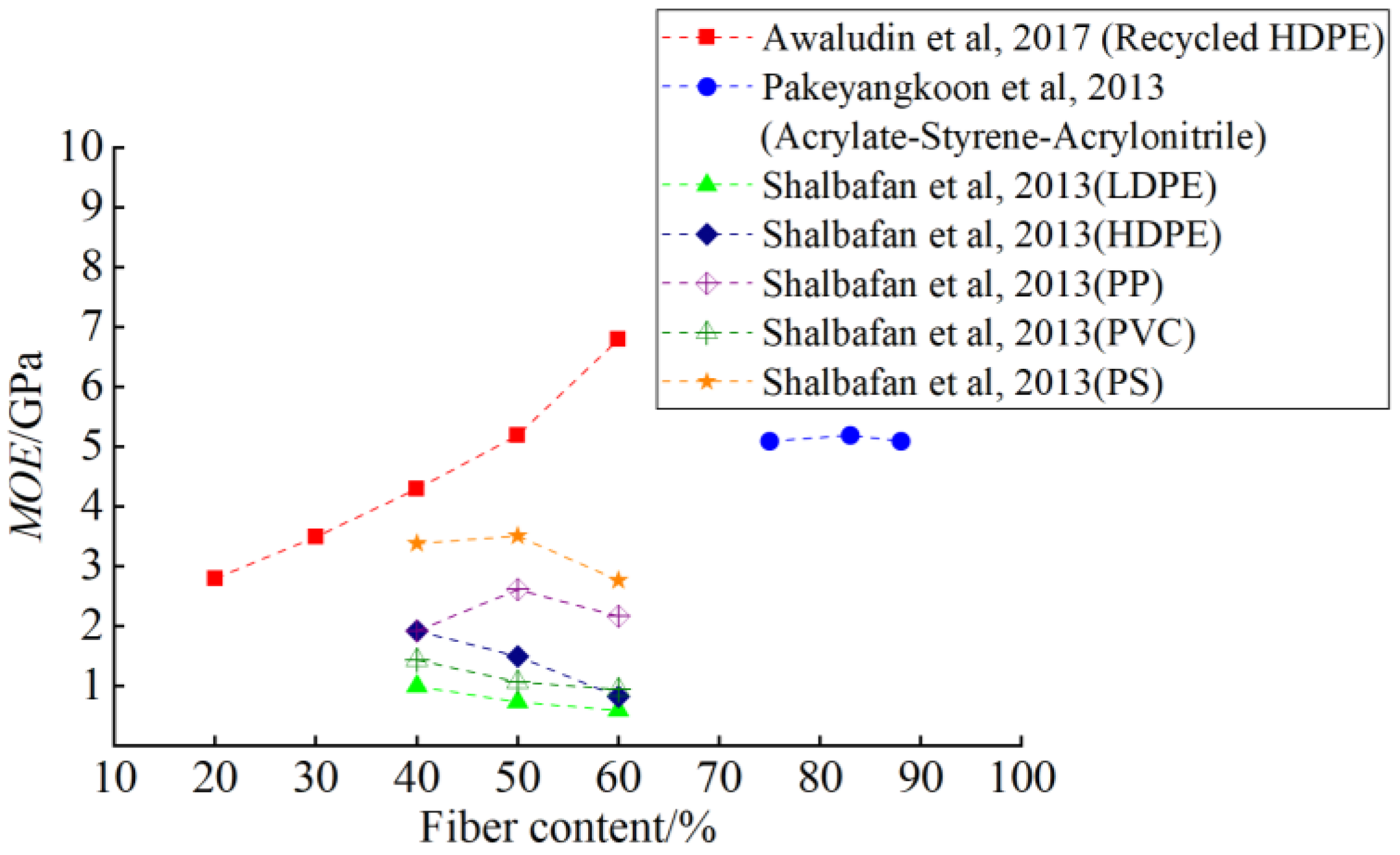A Review on Flexural Properties of Wood-Plastic Composites
Abstract
1. Introduction
2. Influence of the Raw Materials
2.1. Influence of the Type of the Material
2.2. Influence of Particle Size, Shape, and Amount of Wood Fiber
2.3. Influence of Plastic Matrix
2.4. Influence of the Environmental Parameters
3. Surface Pretreatment
3.1. Physical Methods
3.2. Chemical Methods
4. Addition of Modifier
5. Other Methods
5.1. Modification by Adding Lignin
5.2. Modification by Adding Nanomaterials
5.3. Modification by Adding Minerals
5.4. Modification by Adding Non-Metallic Microfibers
6. Conclusions
Author Contributions
Funding
Acknowledgments
Conflicts of Interest
References
- Olonisakin, K.; He, S.; Yang, Y.; Wang, H.; Li, R.; Yang, W. Influence of stacking sequence on mechanical properties and moisture absorption of epoxy-based woven flax and basalt fabric hybrid composites. Sustain. Struct. 2022, 2, 16. [Google Scholar] [CrossRef]
- Scott, E.; Hamel; John, C.; Hermanson; Steven, M. Cramer Predicting the Flexure Response of Wood-Plastic Composites from Uni-Axial and Shear Data Using a Finite-Element Model. J. Mater. Civ. Eng. 2014, 26, 9. [Google Scholar] [CrossRef]
- Ratanawilai, T.; Taneerat, K. Alternative polymeric matrices for wood-plastic composites: Effects on mechanical properties and resistance to natural weathering. Constr. Build. Mater. 2018, 172, 349–357. [Google Scholar] [CrossRef]
- Ramesh, R.S.; Sadashivappa, K.; Sharanaprabhu, L. Physical and Mechanical Properties: Hot pressed Phenol Formaldehyde based Wood Plastic Composite. Mater. Today Proc. 2018, 5, 25331–25340. [Google Scholar] [CrossRef]
- Liu, K.; Jayaraman, D.; Shi, Y.; Harries, K.; Yang, J.; Jin, W.; Shi, Y.; Wu, J.; Jacome, P.; Trujillo, D. “Bamboo: A Very Sustainable Construction Material”—2021 International Online Seminar summary report. Sustain. Struct. 2022, 2, 15. [Google Scholar] [CrossRef]
- Englund, K.; Villechevrolle, V. Flexure and water sorption properties of wood thermoplastic composites made with polymer blends. J. Appl. Polym. Sci. 2010, 120, 1034–1039. [Google Scholar] [CrossRef]
- Binhussain, M.A.; El-Tonsy, M.M. Palm leave and plastic waste wood composite for out-door structures. Constr. Build. Mater. 2013, 47, 1431–1435. [Google Scholar] [CrossRef]
- Wu, M.; Zhao, M.; Chang, G.; Hu, X.; Guo, Q. A composite obtained from waste automotive plastics and sugarcane skin flour: Mechanical properties and thermo-chemical analysis. Powder Technol. 2019, 347, 27–34. [Google Scholar] [CrossRef]
- Dauletbek, A.; Li, H.; Xiong, Z.; Lorenzo, R. A review of mechanical behavior of structural laminated bamboo lumber. Sustain. Struct. 2021, 1, 4. [Google Scholar] [CrossRef]
- Chan, C.M.; Vandi, L.; Pratt, S.; Halley, P.; Richardson, D.; Werker, A.; Laycock, B. Composites of Wood and Biodegradable Thermoplastics: A Review. Polym. Rev. 2018, 58, 444–494. [Google Scholar] [CrossRef]
- Hietala, M.; Samuelsson, E.; Niinimäki, J.; Oksman, K. The effect of pre-softened wood chips on wood fibre aspect ratio and mechanical properties of wood–polymer composites. Compos. Part A Appl. Sci. Manuf. 2011, 42, 2110–2116. [Google Scholar] [CrossRef]
- Zhang, L.; Sun, J.; Yu, Q.; Li, R.; Zhang, Y. Effect of hydrophobic modification of wood powder on properties of HDPE based wood plastic composite. Prog. Chem. Ind. 2020, 39, 3487–3493. [Google Scholar] [CrossRef]
- Pelaez-Samaniego, M.R.; Yadama, V.; Lowell, E.; Amidon, T.E.; Chaffee, T.L. Hot water extracted wood fiber for production of wood plastic composites (WPCs). Holzforschung 2013, 67, 193–200. [Google Scholar] [CrossRef]
- Grubbström, G.; Holmgren, A.; Oksman, K. Silane-crosslinking of recycled low-density polyethylene/wood composites—ScienceDirect. Compos. Part A Appl. Sci. Manuf. 2010, 41, 678–683. [Google Scholar] [CrossRef]
- Acosta, A.; Gallio, E.; Zanatta, P.; Schulz, H.; Delucis, R.A.; Gatto, D. Juvenile and Mature Pinewoods Treated by in situ Polymerization with Poly (vinyl acetate). Fibers Polym. 2021, 22, 745–750. [Google Scholar] [CrossRef]
- Hietala, M.; Niinimäki, J.; Oksman, K. Processing of wood chip–plastic composites: Effect on wood particle size, microstructure and mechanical properties. Plastics. Rubber Compos. 2011, 40, 49–56. [Google Scholar] [CrossRef]
- Lou, C.; Lin, C.; Huang, C.; Hsieh, C.; Lin, J. Compatibility and mechanical properties of maleicanhydride modified the wood plastic composite. J. Reinf. Plast. Compos. 2013, 32, 802–810. [Google Scholar] [CrossRef]
- Ma, Y.; He, H.; Huang, B.; Jing, H.; Zhao, Z. In situ fabrication of wood flour/nano silica hybrid and its application in polypropylene-based wood-plastic composites. Polym. Compos. 2020, 41, 573–584. [Google Scholar] [CrossRef]
- Chen, F.; Han, G.; Li, Q.; Gao, X.; Cheng, W. High-Temperature Hot Air/Silane Coupling Modification of Wood Fiber and Its Effect on Properties of Wood Fiber/HDPE Composites. Materials 2017, 10, 286. [Google Scholar] [CrossRef] [PubMed]
- Shen, F.; Jia, R. Research progress and Development prospect of wood plastic composite. Plast. Addit. 2010, 1, 5–9. [Google Scholar] [CrossRef]
- Li, Y. Study on mechanical properties of glass fiber/wood plastic composites reinforced by surface modifier. Plast. Sci. Technol. 2021, 49, 32–36. [Google Scholar] [CrossRef]
- Hong, H.; Guo, Q.; Zhang, H.; He, H. Effect of interfacial modifiers and wood flour treatment on the rheological properties of recycled polyethylene/wood flour composites. Prog. Rubber Plast. Recycl. Technol. 2019, 36, 147776061989501. [Google Scholar] [CrossRef]
- Li, R. Study on preparation and properties of weather-resistant PE based wood plastic composite. Plast. Sci. Technol. 2021, 49, 47–51. [Google Scholar] [CrossRef]
- Meng, L.; Liu, M.; Li, C.; Meng, L. Research progress of inorganic mineral reinforced wood plastic composite. Miner. Chem. Processing 2021, 50, 32–36. [Google Scholar] [CrossRef]
- Hu, F.; Li, H.; Wu, Z.; Yu, L.; Cao, R.; Xu, H. Research status of nano-reinforced wood-plastic composites. World For. Res. 2022, 35, 63–68. [Google Scholar] [CrossRef]
- Mimendi, L.; Lorenzo, R.; Li, H. An innovative digital workflow to design, build and manage bamboo structures. Sustain. Struct. 2022, 2, 11. [Google Scholar] [CrossRef]
- Zhou, K.; Li, H.; Hong, C.; Ashraf, M.; Sayed, U.; Lorenzo, R.; Corbi, I.; Corbi, O.; Yang, D.; Zuo, Y. Mechanical properties of large-scale parallel bamboo strand lumber under local compression. Constr. Build. Mater. 2021, 271, 121572. [Google Scholar] [CrossRef]
- Zhou, Y.; Huang, Y.; Sayed, U.; Wang, Z. Research on dynamic characteristics test of wooden floor structure for gymnasium. Sustain. Struct. 2021, 1, 5. [Google Scholar] [CrossRef]
- Zhang, D.; Gong, M.; Zhang, S.; Zhu, X. A review of tiny houses in North America: Market demand. Sustain. Struct. 2022, 2, 12. [Google Scholar] [CrossRef]
- Ponzo, F.C.; Antonio, D.C.; Nicla, L.; Nigro, D. Experimental estimation of energy dissipated by multistorey post-tensioned timber framed buildings with anti-seismic dissipative devices. Sustain. Struct. 2021, 1, 7. [Google Scholar] [CrossRef]
- Arwinfar, F.; Hosseinihashemi, S.K.; Latibari, A.J.; Lashgari, A.; Ayrilmis, N. Mechanical Properties and Morphology of Wood Plastic Composites Produced with Thermally Treated Beech Wood. BioResources 2016, 11, 1494–1504. [Google Scholar] [CrossRef][Green Version]
- Quintero, M.A.M.; Tam, C.P.T.; Li, H. Structural analysis of a Guadua bamboo bridge in Colombia. Sustain. Struct. 2022, 2, 20. [Google Scholar] [CrossRef]
- Mu, B.; Wang, H.; Hao, X.; Wang, Q. Morphology, Mechanical Properties and Dimensional Stability of Biomass Particles/High Density Polyethylene Composites: Effect of Species and Composition. Polymers 2018, 10, 308. [Google Scholar] [CrossRef] [PubMed]
- Xu, J.; Hao, X.; Zhou, H.; Sun, L.; Liu, T.; Wang, Q.; Ou, R. High and low temperature performance of ultra-high filled polypropylene-based wood plastic composite. J. Compos. Mater. 2021, 38, 1–15. [Google Scholar] [CrossRef]
- Xu, H.; Cao, Y.; Yang, X.; Gao, H.; Shan, W.; Hao, J. Mechanical properties and Simulation of wood plastic composites. Plast. Ind. 2020, 48, 132–135,155. Available online: https://kns.cnki.net/kcms/detail/detail.aspx?FileName=SLGY2020S1033&DbName=CJFQ2020 (accessed on 3 August 2022).
- Liu, K. The Pulp Fiber/Polymer Preparation and Properties of Wood Plastic Composite Research. Master’s Thesis, South China University of Technology, Guangzhou, China, 2020. [Google Scholar] [CrossRef]
- Cai, H.; Yang, K.; Yi, W. Effects of calcium carbonate on preparation and mechanical properties of wood/plastic composite. Int. J. Agric. Biol. Eng. 2017, 10, 184–190. [Google Scholar] [CrossRef]
- Turku, I.; Kärki, T. Reinforcing wood–plastic composites with macro- and micro-sized cellulosic fillers: Comparative analysis. J. Reinf. Plast. Compos. 2013, 32, 1746–1756. [Google Scholar] [CrossRef]
- Chaudemanche, S.; Perrot, A.; Pimbert, S.; Lecompte, T.; Faure, F. Properties of an industrial extruded HDPE-WPC: The effect of the size distribution of wood flour particles. Constr. Build. Mater. 2018, 162, 543–552. [Google Scholar] [CrossRef]
- Leu, S.; Yang, T.; Lo, S.; Yang, T. Optimized material composition to improve the physical and mechanical properties of extruded wood–plastic composites (WPCs). Constr. Build. Mater. 2012, 29, 120–127. [Google Scholar] [CrossRef]
- Petchwattana, N.; Covavisaruch, S. Effects of Rice Hull Particle Size and Content on the Mechanical Properties and Visual Appearance of Wood Plastic Composites Prepared from Poly (vinyl chloride). J. Bionic Eng. 2013, 10, 110–117. [Google Scholar] [CrossRef]
- Wang, H.; Wang, Q.; Xie, Y.; Song, Y. Effects of Geometrical Shapes of Wood Particles on the Mechanical and Water-Uptake Properties of the Resulting Wood/High Density Polyethylene Composites. Adv. Mater. Res. 2010, 113–116, 674–678. [Google Scholar] [CrossRef]
- Schirp, A.; Mannheim, M.; Plinke, B. Influence of refiner fibre quality and fibre modification treatments on properties of injection-moulded beech wood–plastic composites. Compos. Part A Appl. Sci. Manuf. 2014, 61, 245–257. [Google Scholar] [CrossRef]
- Delviawan, A.; Kojima, Y.; Kobori, H.; Suzuki, S.; Aoki, K.; Ogoe, S. The effect of wood particle size distribution on the mechanical properties of wood–plastic composite. J. Wood Sci. 2019, 65, 67. [Google Scholar] [CrossRef]
- Awaludin, A.; Yudhia, P.; Satyarno, I. Physical and mechanical properties of WPC Board from Sengon sawdust and recycled HDPE plastic. Procedia Eng. 2017, 171, 695–704. [Google Scholar] [CrossRef]
- Mertens, O.; Krause, K.C.; Weber, M.; Krause, A. Performance of thermomechanical wood fibers in polypropylene composites. Wood Mater. Sci. Eng. 2020, 15, 114–122. [Google Scholar] [CrossRef]
- Barbos, J.D.V.; Azevedo, J.B.; Pollyana da Silva, M.C.; da Costa Garcia Filho, F.; del Rio, T.G. Development and characterization of WPCs produced with high amount of wood residue. J. Mater. Res. Technol. 2020, 9, 9684–9690. [Google Scholar] [CrossRef]
- Pakeyangkoon, P.; Ploydee, B. Mechanical Properties of Acrylate-Styrene-Acrylonitrile/Bagasse Composites. Adv. Mater. Res. 2013, 747, 355–358. [Google Scholar] [CrossRef]
- Shalbafan, A.; Benthien, J.T.; Welling, J.; Barbu, M.C. Flat pressed wood plastic composites made of milled foam core particleboard residues. Eur. J. Wood Wood Prod. 2013, 71, 805–813. [Google Scholar] [CrossRef]
- Ayrilmis, N.; Kaymakci, A.; Güleç, T. Potential use of decayed wood in production of wood plastic composite. Ind. Crops Prod. 2015, 74, 279–284. [Google Scholar] [CrossRef]
- Hosseinihashemi, S.K.; Shamspour, M.; Safdari, V.; Pourmousa, S.; Ayrilmis, N. The influences of poplar inner and outer bark content on mechanical properties of wood/polypropylene composites. J. Chil. Chem. Soc. 2017, 62, 3365–3369. [Google Scholar] [CrossRef]
- Hartmann, R.; Koch, M. Wood chip plastic composite—A novel bio-based material with high mechanical properties. Polimery 2017, 62, 556–559. [Google Scholar] [CrossRef]
- Yang, W.; Xie, Y.; Wang, H.; Liu, B.; Wang, Q. Impacts of freezing and thermal treatments on dimensional and mechanical properties of wood flour-HDPE composite. For. Res. 2013, 24, 5. [Google Scholar] [CrossRef]
- Jiang, T.; Zeng, G.; Hu, C. Fabrication of highly filled wood plastic composite pallets with extrusion-compression molding technique. Polym. Compos. 2020, 41, 2724–2731. [Google Scholar] [CrossRef]
- Gao, X.; Li, Q.; Cheng, W.; Han, G.; Xuan, L. Effects of moisture content, wood species, and form of raw materials on fiber morphology and mechanical properties of wood fiber-HDPE composites. Polym. Compos. 2018, 39, 3236–3246. [Google Scholar] [CrossRef]
- Zhang, M.; Lv, J.; Bao, X.; Li, P.; Yuan, G.; Zuo, Y. Effect of silane coupling agent KH590 on surface properties of silicate modified poplar. J. For. Eng. 2021, 6, 82–87. [Google Scholar] [CrossRef]
- Chen, Y.; Yang, Y.; Zhang, Z. Effect of interfacial treatment on mechanical properties of wood-plastic composites. For. Prod. Ind. 2020, 57, 13–16,40. [Google Scholar] [CrossRef]
- Yu, W.; Liu, Q.; Yang, C.; Liu, J.; Shi, Y.; Lei, W. Comparative study on properties of different plastic-based WPC composites. Plast. Ind. 2020, 48, 121–125. [Google Scholar] [CrossRef]
- Murayama, K.; Suzuki, S.; Kojima, Y.; Kobori, H.; Ito, H.; Ogoe, S.; Okamoto, M. The Effects of Different Types of Maleic Anhydride-Modified Polypropylene on the Physical and Mechanical Properties of Polypropylene-based Wood/Plastic Composites. J. Wood Chem. Technol. 2018, 38, 1–9. [Google Scholar] [CrossRef]
- Gao, H.; Wang, Q.; Wang, H.; Song, Y. Properties of Highly Filled Wood Fiber-Maleic Anhydride Grafted Thermoplastic Blends Composites. Adv. Mater. Res. 2010, 113–116, 1856–1860. [Google Scholar] [CrossRef]
- Zhang, X.; Gao, T.; Zhang, T.; Liu, Q. Effect of different molecular weight polyethylene glycol on properties of polylactic acid-based wood plastic composite. Eng. Plast. Appl. 2021, 49, 27–30,47. [Google Scholar] [CrossRef]
- Wang, F. Aluminium/Wood Plastic Composite and SLS Parts Mechanical Properties and Microwave Processing Research. Ph.D. Thesis, Northeast Forestry University, Harbin, China, 2021. [Google Scholar] [CrossRef]
- Chen, Y.; Shi, C.; Zhang, Z. Effect of surface modification of multi-walled carbon nanotubes on the properties of wood-plastic composites. For. Ind. 2020, 57, 15–21. [Google Scholar] [CrossRef]
- Kaymakci, A. Effect of titanium dioxide on some mechanical, thermal, and surface properties of wood-plastic nanocomposites. BioResources 2019, 14, 1969–1979. [Google Scholar] [CrossRef]
- Zhang, W.; Lu, Q.; Liu, S.; Zhao, B. Study on properties and interfacial treatment of PLA wood-plastic composites. Eng. Plast. Appl. 2020, 48, 39–43. [Google Scholar] [CrossRef]
- Valles-Rosales, D.J.; Rodríguez-Picón, L.A.; Méndez-González, L.C.; del Valle-Carrasco, A.; Alodan, H. Analysis of the mechanical properties of wood-plastic composites based on agriculture Chili pepper waste. Maderas Cienc. Y Tecnol. 2016, 18, 1–19. [Google Scholar] [CrossRef]
- Farsi, M. Effect of Nano-SiO2 and Bark Flour Content on the Physical and Mechanical Properties of Wood–Plastic Composites. J. Polym. Environ. 2017, 25, 308–314. [Google Scholar] [CrossRef]
- Ling, Z.; Lai, C.; Huang, C.; Xu, F.; Yong, Q. Research progress in variations of cellulose supramolecular structures via biomass pretreatment. J. For. Eng. 2021, 6, 24–34. [Google Scholar] [CrossRef]
- Leng, W.; He, S.; Zhang, X.; Zhai, S.; Wang, X.; Pan, B.; Shi, J. Research progress and thoughts on the modification mechanism of wood furfurylation. J. For. Eng. 2021, 6, 35–43. [Google Scholar] [CrossRef]
- Sun, Q.; Yang, Y.; Tang, B.; Chen, Y.; Wang, Y.; Zhang, J.; Qiu, J. Research progress on preparation of micro-nano structures on biomimetic superhydrophobic wood surface. J. For. Eng. 2021, 6, 1–11. [Google Scholar] [CrossRef]
- Liu, Y.; Li, A.; Cao, J.; Yu, D.; Zhang, J. Mechanical properties of timber-concrete connections with steel tube connectors. Sustain. Struct. 2022, 2, 17. [Google Scholar] [CrossRef]
- Perisic, S.D.; Radovic, I.; Petrovic, M.; Marinkovic, A.; Stojanovic, D.; Uskokovic, P.; Radojevic, V. Processing of hybrid wood plastic composite reinforced with short PET fibers. Mater. Manuf. Processes 2018, 33, 572–579. [Google Scholar] [CrossRef]
- Zhou, Z.; Xu, M.; Yang, Z.; Li, X.; Shao, D. Effect of maleic anhydride grafted polyethylene on the properties of chopped carbon fiber/wood plastic composites. J. Reinf. Plast. Compos. 2014, 33, 1216–1225. [Google Scholar] [CrossRef]
- Bengtsson, M.; Oksman, K. Silane crosslinked wood plastic composites: Processing and properties. Compos. Sci. Technol. 2006, 66, 2177–2186. [Google Scholar] [CrossRef]
- Hao, X.; Xu, J.; Zhou, H.; Tang, W.; Li, W.; Wang, Q.; Ou, R. Interfacial adhesion mechanisms of ultra-highly filled wood fiber/polyethylene composites using maleic anhydride grafted polyethylene as a compatibilizer. Mater. Des. 2021, 212, 110182. [Google Scholar] [CrossRef]
- Gao, X.; Lin, L.; Pang, J.; Chen, F.; Li, Q. Effects of impulse-cyclone drying and silane modification on the properties of wood fiber/HDPE composite material. Carbohydr. Polym. 2019, 207, 343–351. [Google Scholar] [CrossRef] [PubMed]
- Li, F.; Xu, Z.; Zhang, X.; Luo, B.; Qin, L.; Xia, Y. Study on the properties of lignin and coffee shell powder to prepare wood-plastic composite. J. Southwest For. Univ. 2021, 41, 139–146. [Google Scholar] [CrossRef]
- Sozen, E.; Aydemir, D.; Zor, M. The Effects of Lignocellulosic Fillers on Mechanical, Morphological and Thermal Properties of Wood Polymer Composites. Drv. Ind. 2017, 68, 195–204. [Google Scholar] [CrossRef]
- Li, F.; Xu, Z.; Zhang, X.; Luo, B.; Qin, L.; Xia, Y. Modified lignin reinforced wood plastic composite and its properties. J. For. Eng. 2020, 5, 45–51. [Google Scholar] [CrossRef]
- Benthien, J.T.; Thoemen, H. Effects of raw materials and process parameters on the physical and mechanical properties of flat pressed WPC panels. Compos. Part A Appl. Sci. Manuf. 2012, 43, 570–576. [Google Scholar] [CrossRef]
- Rangavar, H.; Taghiyari, H.R.; Oromiehie, A.; Gholipour, T.; Safarpour, A. Effects of nanoclay on physical and mechanical properties of wood-plastic composites. Wood Mater. Sci. Eng. 2017, 12, 211–219. [Google Scholar] [CrossRef]
- Kaymakci, A. Effect of sepiolite clay nanofibers on physical, mechanical, and thermal properties of wood-plastic nanocomposites. J. Thermoplast. Compos. Mater. 2020, 1063432867. [Google Scholar] [CrossRef]
- Ghalehno, M.D.; Kord, B.; Sheshkal, B.N. Mechanical and physical properties of wood/polyethylene composite reinforced with tio2 nanoparticles. Cerne 2020, 26, 474–481. [Google Scholar] [CrossRef]
- Zhang, Y.; Fang, J.; Li, J.; Guo, Y.; Wang, Q. The Effect of Carbon Nanotubes on the Mechanical Properties of Wood Plastic Composites by Selective Laser Sintering. Polymers 2017, 9, 728. [Google Scholar] [CrossRef] [PubMed]
- Zhang, X.; Hao, X.; Hao, J.; Wang, Q. Heat transfer and mechanical properties of wood-plastic composites filled with flake graphite. Thermochim. Acta 2018, 664, 26–31. [Google Scholar] [CrossRef]
- Zhang, K.; Sun, J.; Li, R.; Zhao, Y. Preparation and properties of wood plastic composite reinforced with organic/inorganic fillers. Plast. Ind. 2020, 48, 158–163. [Google Scholar] [CrossRef]
- Li, Q.; Gao, X.; Cheng, W.; Han, G.; Han, J. Preparation and performance of high-density polyethylene-based wood–plastic composites reinforced with red pottery clay. J. Reinf. Plast. Compos. 2017, 36, 853–863. [Google Scholar] [CrossRef]
- Li, X.; Lei, B.; Lin, Z.; Huang, L.; Tan, S.; Cai, X. The utilization of organic vermiculite to reinforce wood–plastic composites with higher flexural and tensile properties. Ind. Crops Prod. 2013, 51, 310–316. [Google Scholar] [CrossRef]
- Taghiyari, H.R.; Tajvidi, M.; Taghiyari, R.; Mantanis, G.I.; Esmailpour, A.; Hosseinpourpia, R. Chapter 19—Nanotechnology for wood quality improvement and protection. Nanomater. Agric. For. Appl. 2020, 469–489. [Google Scholar] [CrossRef]
- Zhang, J.; Li, Y.; Xing, D.; Wang, Q.; Wang, H.; Koubaa, A. Reinforcement of continuous fibers for extruded wood-flour/HDPE composites: Effects of fiber type and amount. Constr. Build. Mater. 2019, 228, 116718. [Google Scholar] [CrossRef]
- Heriyanto; Pahlevani, F.; Sahajwalla, V. Waste glass powder—Innovative value-adding resource for hybrid wood-based products. J. Clean. Prod. 2018, 195, 215–225. [Google Scholar] [CrossRef]
- Li, X.; Lei, B.; Lin, Z.; Huang, L.; Tan, S.; Cai, X. The utilization of bamboo charcoal enhances wood plastic composites with excellent mechanical and thermal properties. Mater. Des. 2014, 53, 419–424. [Google Scholar] [CrossRef]
- Mosavi-Mirkolaei, S.T.; Najafi, S.K.; Tajvidi, M. Physical and Mechanical Properties of Wood-Plastic Composites Made with Microfibrillar Blends of LDPE, HDPE and PET. Fibers Polym. 2019, 20, 2156–2165. [Google Scholar] [CrossRef]
- Zhang, J.; Wang, H.; Ou, R.; Wang, Q. The properties of flax fiber reinforced wood flour/high density polyethylene composites. J. For. Res. 2017, 29, 533–540. [Google Scholar] [CrossRef]
- Naghipour, M.; Nematzadeh, M.; Yahyazadeh, Q. Analytical and experimental study on flexural performance of WPC–FRP beams. Constr. Build. Mater. 2011, 25, 829–837. [Google Scholar] [CrossRef]
- Wang, Z.; Hu, C.; Gu, J.; Cherdchim, B.; Tu, D.; Guan, L. Effects of extractives on mechanical properties and durability of rubberwood-HDPE composites. Holzforschung 2020, 74, 1061–1070. [Google Scholar] [CrossRef]
- Kumar, S.; Vedrtnam, A.; Pawar, S.J. Effect of wood dust type on mechanical properties, wear behavior, biodegradability, and resistance to natural weathering of wood-plastic composites. Front. Struct. Civ. Eng. 2019, 13, 1446–1462. [Google Scholar] [CrossRef]
- Li, H.; Chen, B.; Fei, B.; Li, H.; Xiong, Z.; Lorenzo, R.; Fang, C.; Ashraf, M. Mechanical properties of aramid fiber reinforced polymer confined laminated bamboo lumber column under cyclic loading. Eur. J. Wood Wood Prod. 2022, 80, 1–14. [Google Scholar] [CrossRef]
- Su, J.; Li, H.; Xiong, Z.; Lorenzo, R. Structural design and construction of an office building with laminated bamboo lumber. Sustain. Struct. 2021, 1, 10. [Google Scholar] [CrossRef]
- Zong, G.; Hao, X.; Hao, J.; Tang, W.; Fang, Y.; Ou, R.; Wang, Q. High-strength, lightweight, co-extruded wood flour-polyvinyl chloride/lumber composites: Effects of wood content in shell layer on mechanical properties, creep resistance, and dimensional stability. J. Clean. Prod. 2020, 244, 118860. [Google Scholar] [CrossRef]
- Hao, X.; Zhou, H.; Sun, L.; Lin, D.; Ou, R.; Wang, Q. Research progress and application of co-extrusion wood-plastic composites. J. For. Eng. 2021, 6, 27–38. [Google Scholar] [CrossRef]
- Siqueira, D.D.; Luna, C.B.B.; Ferreira, E.S.B.; Araújo, E.M.; Wellen, R.M.R. Tailored PCL/Macaíba fiber to reach sustainable biocomposites. J. Mater. Res. Technol. 2020, 9, 9691–9708. [Google Scholar] [CrossRef]
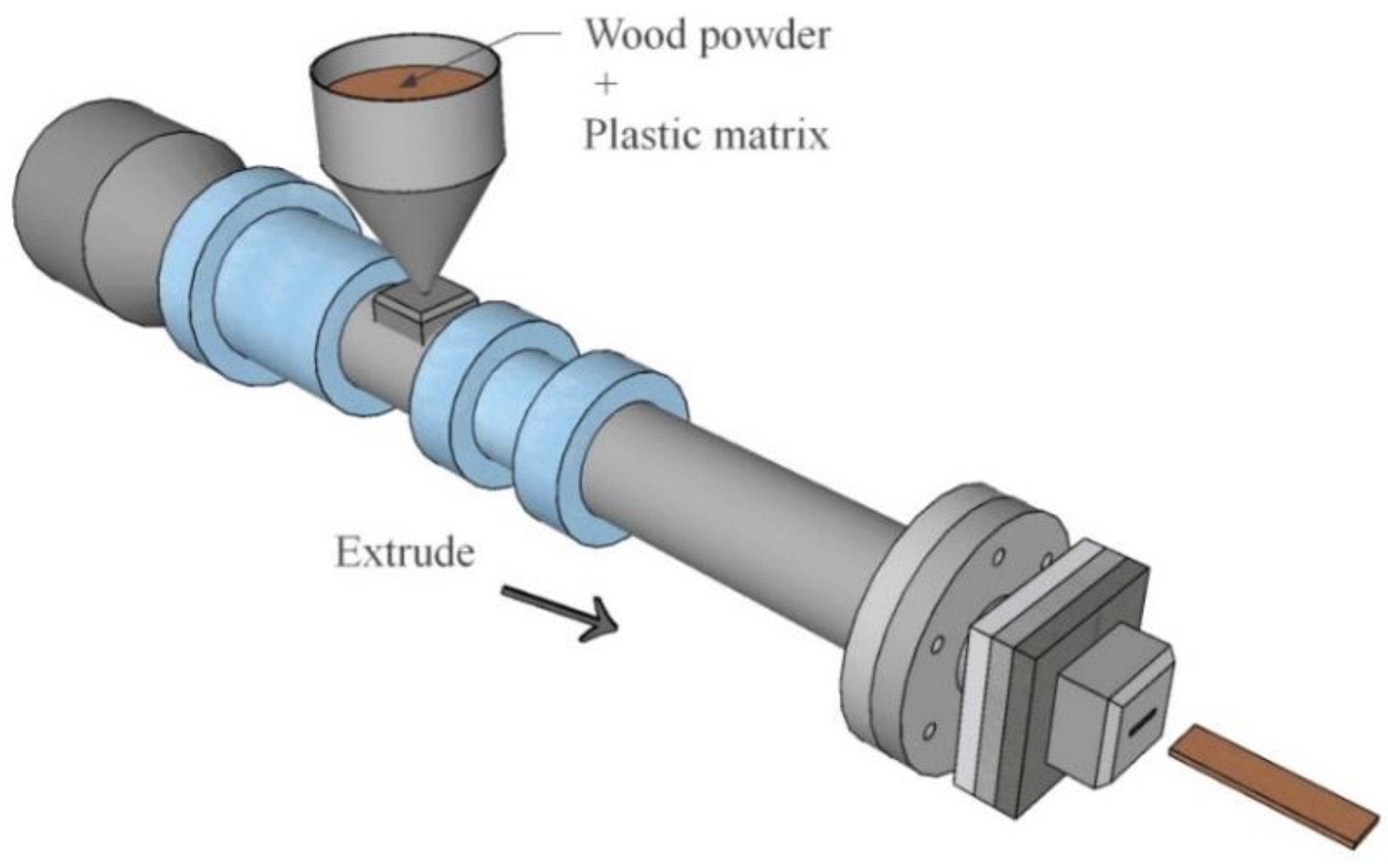
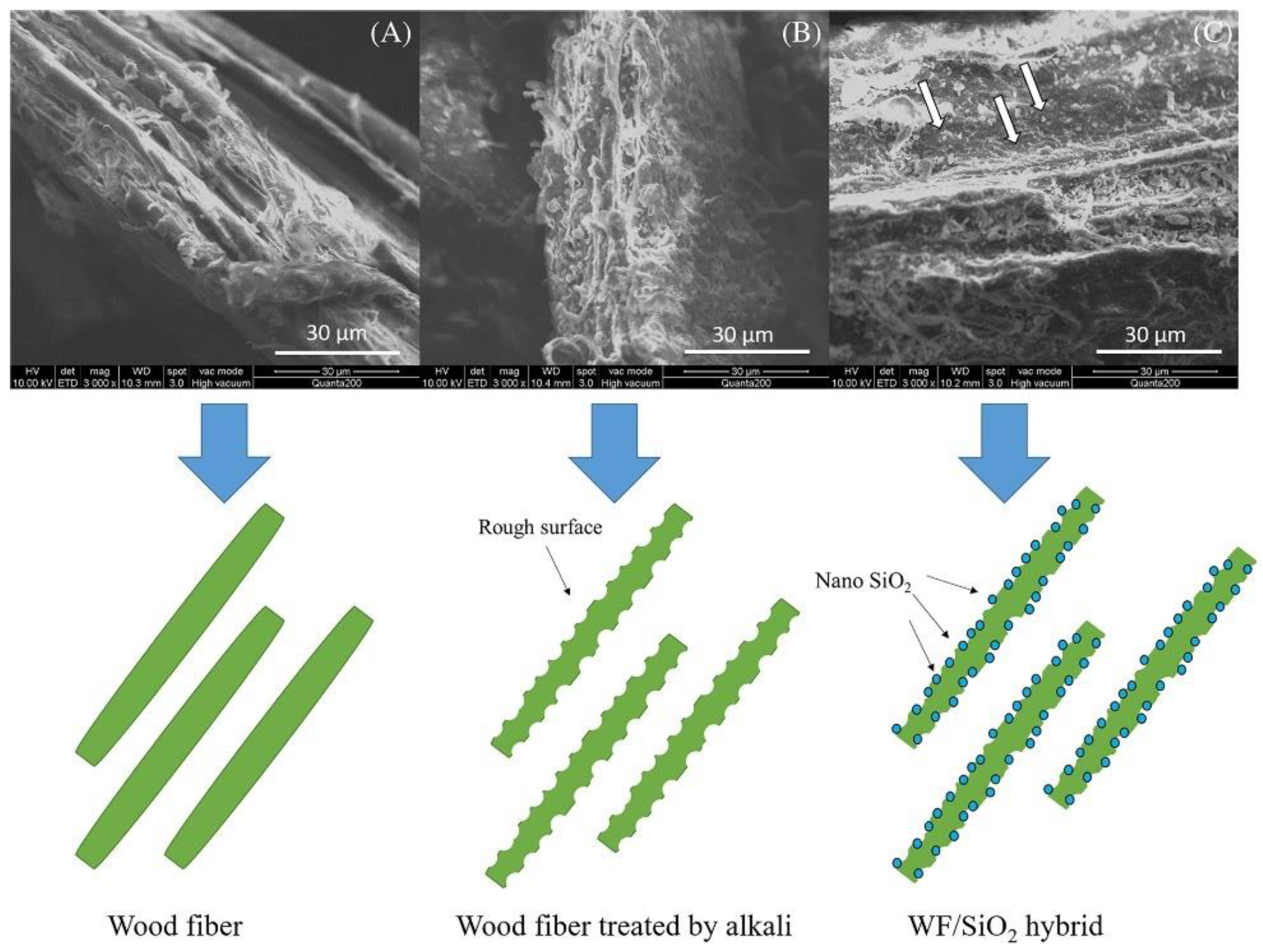
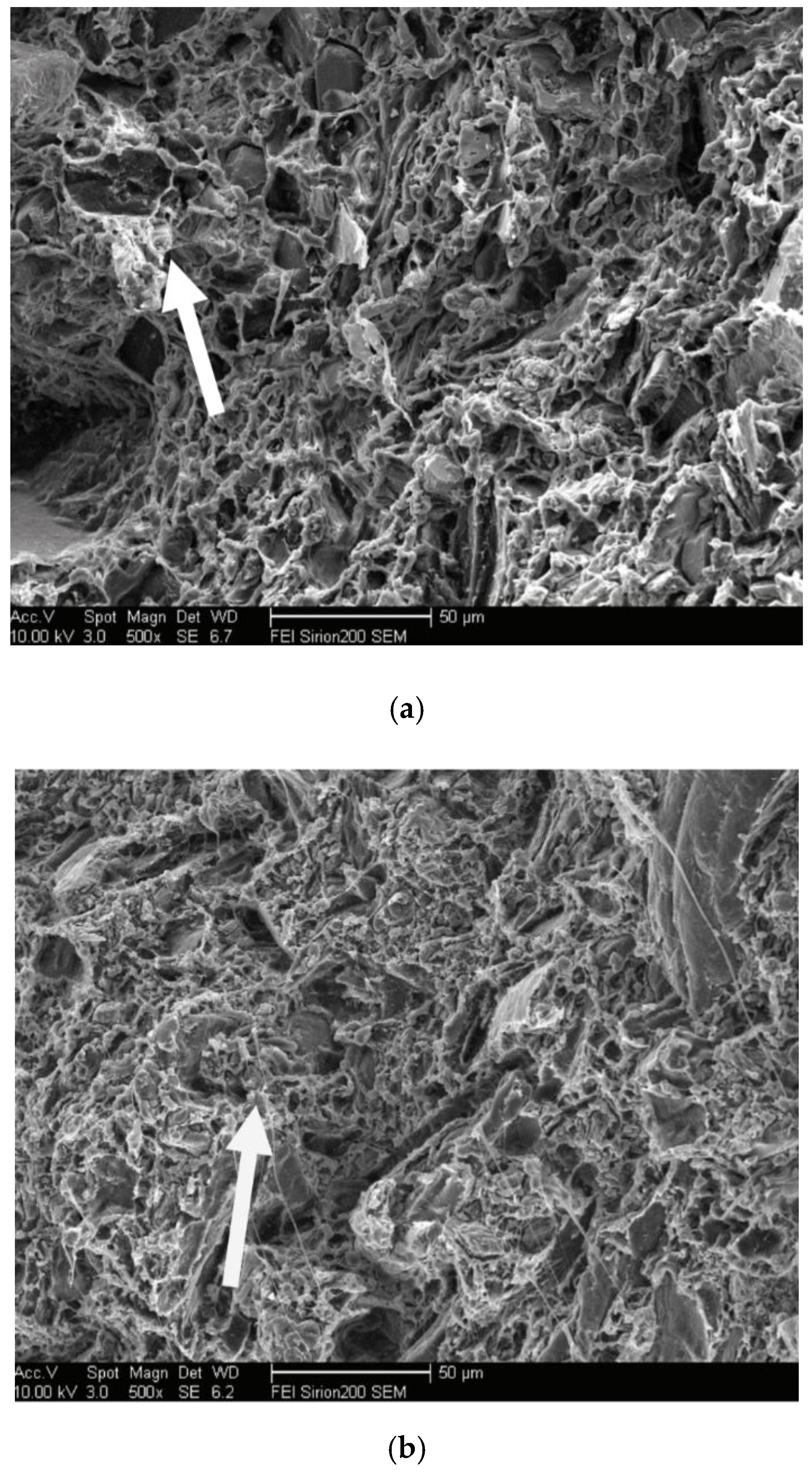
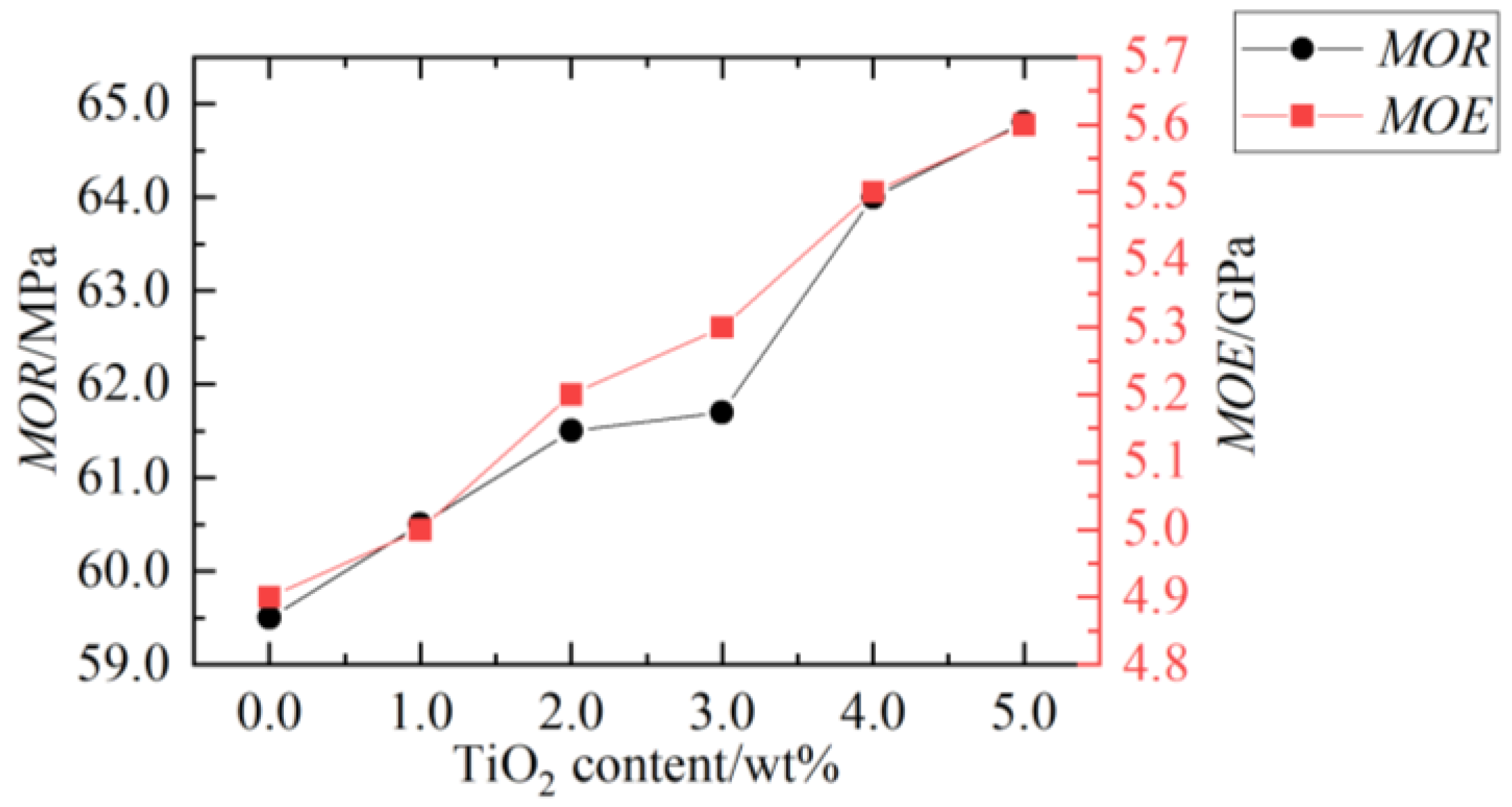
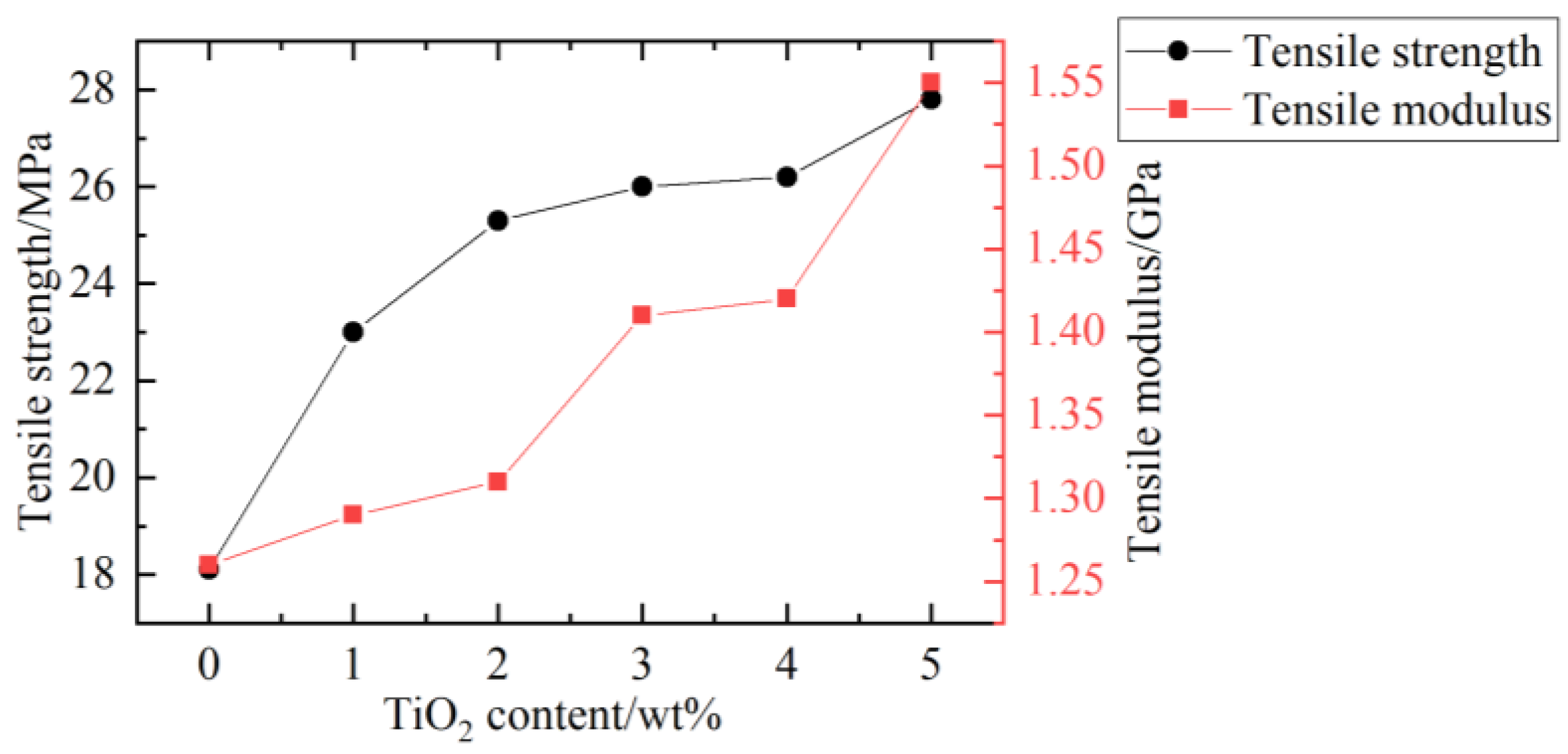
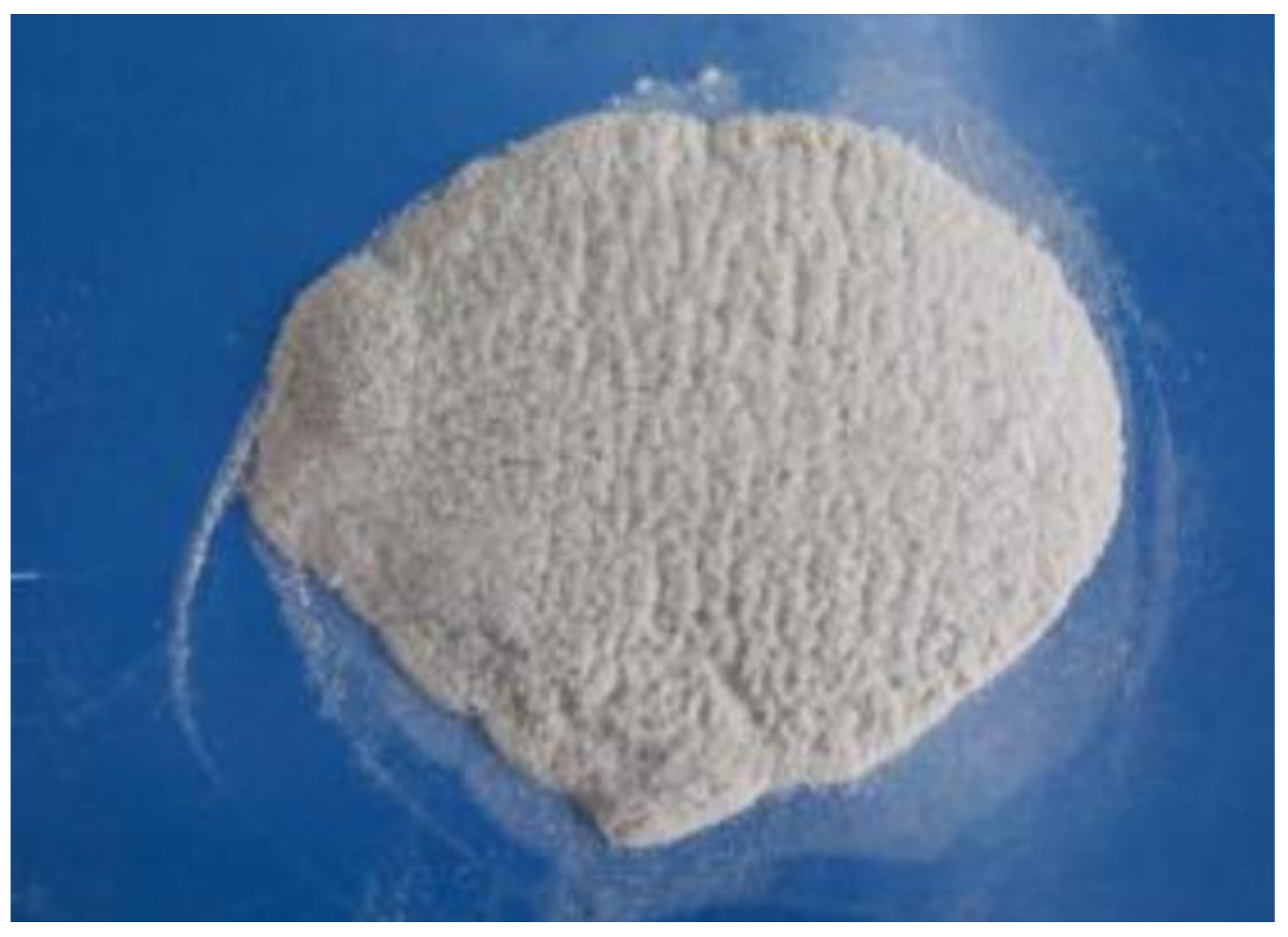
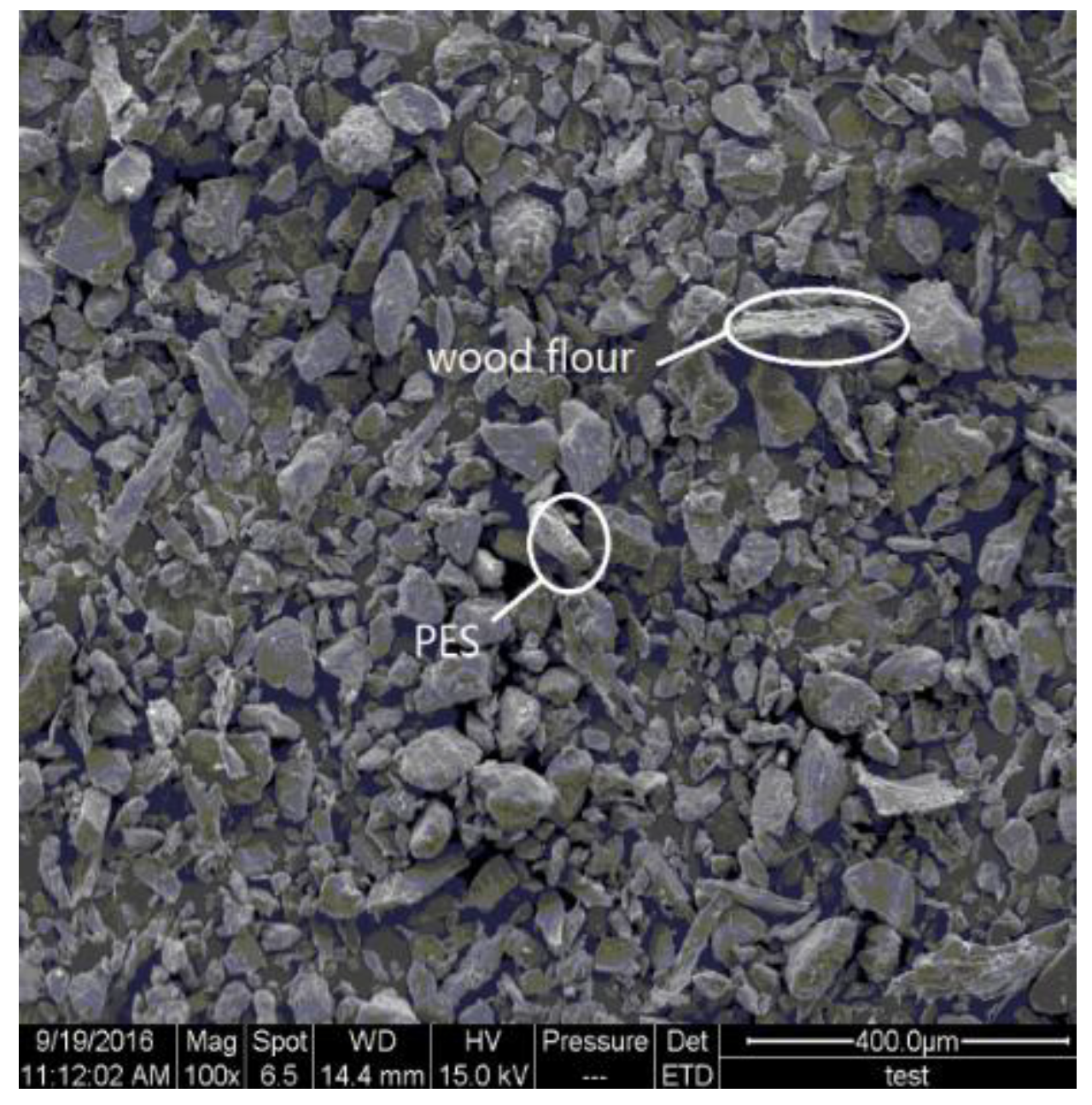

| References | Wood | Plastic Matrix | Wood Fiber Content (wt.%) | Bending Strength (MPa) | Bending Modulus (GPa) |
|---|---|---|---|---|---|
| [35] | Pinus massoniana | HDPE | 60 | 43.3 | 3.2 |
| [35] | Chinese fir | HDPE | 60 | 63.9 | 4.0 |
| [36] | Mechanical pulp of bagasse | HDPE | 50 | 65.9 | - |
| [50] | Scottish loose | PP | 50 | 24.8 | 3.784 |
| [51] | Populus amurensis | PP | 38 | 40.5 | 1.891 |
| [42] | Populus amurensis | HDPE | 59.7 | 59.27 | 2.73 |
| [44] | Pinus densifora | PP | 25 | - | 3.6 |
| [45] | Sengon sawdust | HDPE | - | 40.39 | 3.353 |
| [46] | Thermomechanical wood fibers | PP | 50 | 76.4 | 5.2 |
| [49] | Spruce and pine | PS | 75 | 35 | 5.1 |
| [59] | Commercial wood flour | PP | 25 | 73.7 | 2.59 |
| [3] | Rubberwood flour | LDPE | 40 | 6.39 | 1.0 |
| HDPE | 60 | 18.79 | 0.83 | ||
| PP | 60 | 37.72 | 2.17 | ||
| PVC | 60 | 15.6 | 0.95 | ||
| PS | 50 | 30.03 | 3.51 | ||
| [60] | Poplar wood | rPP/ PE | 60 | 52.4 | 6.06 |
| rPP/PE/PS | 52.9 | 5.49 | |||
| [4] | Saguvani | Phenol formaldehyde (PF) | |||
| [61] | Wood flour | PLA | 18.5 | 95.3 | - |
| [62] | Pine powder | Polyethersulfone resin (PES) | 14.3 | 16.8 | - |
| [63] | Poplar | HDPE | 60 | 27.47 | 2.4 |
| [64] | Pinus sylvestris | PP | 50 | 64.8 | 5.6 |
| [65] | Rice husk | PLA | 30 | 11.27 | |
| Bamboo powder | 14.17 | ||||
| Poplar powder | 16.26 | ||||
| [66] | Chili-stems waste particles | PP | 21.25 | 22.9 | 0.024 |
| 42.5 | 16.2 | 0.0255 | |||
| [67] | Bark flour | HDPE | 50 | ||
| Beech-wood flour | 50 |
| References | Wood | Plastic Matrix | The Amount of Wood Fiber (wt.%) | Modification Method | The Increase in Bending Strength (%) | The Increase in Bending Modulus (%) |
|---|---|---|---|---|---|---|
| [12] | Wood flour (80 mesh) | HDPE | 50 | Hydrophobic modification of Methyl methacrylate (MMA) | 17.3 | 24.4 |
| Butyl methacrylate (BMA) | 26.3 | 24.4 | ||||
| Styrene (St) | 27.5 | 26.0 | ||||
| [17] | Coir | PP | 5–15 | The coir is treated with 17.5% alkali for 1 h | 10 | - |
| [18] | Wood flour (80 mesh) | PP | 38.48 | The addition of nanosilica (1.52 wt.%) | - | - |
| [19] | poplar wood (60–80 m) | HDPE | 50 | high-temperature hot air (HTHA) treatment and silane coupling agent | - | - |
| [21] | Poplar flour (60 m) | HDPE | 30 | Addition of optimized glass fiber (GF, 15%) | 6.8 | - |
| [37] | Eucalyptus wood | recycled polyethylene (rPE) | 50 | Addition of ternary-monomer graft copolymers | ||
| [62] | Pine powder | Polyethersulfone resin (PES) | 14.3 | Micron-scale aluminum powder is added (0.1 wt.%) | 130.36 | - |
| [63] | Poplar (80–100 m) | HDPE | 60 | Multi-walled carbon nanotubes were added (0.5 wt.%) | 5.8 | 13.7 |
| [64] | Pinus sylvestris | PP | 50 | Nano-TiO2 was added (5 wt.%) | 8.9 | 14.3 |
| [65] | bamboo powder | PLA | 30 | Silane coupling agent was added | - | - |
| [75] | Populus adenopoda, 40–80 mesh | HDPE | 80 | Ultra-highly filled wood fiber/PE composites (UH-WPCs) was fabricated by using maleic anhydride grafted polyethylene (MAPE) as compatibilizer | 189 | |
| [76] | poplar | HDPE | 50 | Impulse-cyclone drying (ICD) and 3% silane was added | 10.22 | |
| [77] | Alkali lignin and Eucalyptus powder | HDPE | Alkali lignin:15 Eucalyptus powder:45 | Eucalyptus powder was replaced with coffee shells | 15.30 | - |
| [83] | Pinus sylvestris | HDPE | 50 | Nano-TiO2 was added (3 wt.%) | 21.88 | - |
| [84] | pine powder | (PES) | 14 | Carbon nanotubes was added (0.1 wt.%) | 227.9 | 128.7 |
| [94] | Poplar (40–80 m) | HDPE | 51 | Flax fiber (FF) was added (9 wt.%) | 14.6 | 51.4 |
| Wood Fiber | Plastics Substrate | Modifying Agent |
|---|---|---|
| Rubberwood [3] Saguvani [4] Coconut chaff [17] Beech wood [31] Radiata pine [33] Wheat straw [33] Moso bamboo [33] Poplar fiber [34] (endothelial powder, skin powder) Bamboo fiber [34] Masson pine wood meal [35] Chinese fir wood meal [35] Pinus massoniana [35] Bagasse [36] Eucalyptus globulus particles [37] Spruce [38] Rice husk [41] Populus amurensis [42] Pinus densifora [44] Sawdust [45] Thermomechanical wood fibers [46] Foam core particleboard [49] Decayed wood powder [50] Scottish loose [50] Pepper leaf [65] Chili-stems waste particles [65] | Low density polyethylene (LDPE) [3] High density polyethylene (HDPE) [3] ABS [3] PS [3] PP [3] PVC [3] Recycled polypropylene (rPP) [40] Polylactic acid (PLA) [47] Polymethyl methacrylate (PMMA) [69] Poly (ether sulfone) [81] | Nano silica [18] Glass fiber [21] Maleic anhydride [37] Calcium carbonate [37] Polyethylene glycol (peg) [47] Acrylic acid [48] Aluminum powder [61] Carbon nanotube [62] Toluene-2, 4-diisocyanate (TDI) [69] Trimethoxysilane (MPTMS) [69] Coffee shell powder [74] Nano clay [78] Sepiolite clay nanofibers [79] Flake graphite [82] Organic vermiculite [85] Bamboo charcoal [86] Recycled plastic microfibers Flax fiber [91] Macaiba [99] |
Publisher’s Note: MDPI stays neutral with regard to jurisdictional claims in published maps and institutional affiliations. |
© 2022 by the authors. Licensee MDPI, Basel, Switzerland. This article is an open access article distributed under the terms and conditions of the Creative Commons Attribution (CC BY) license (https://creativecommons.org/licenses/by/4.0/).
Share and Cite
Jian, B.; Mohrmann, S.; Li, H.; Li, Y.; Ashraf, M.; Zhou, J.; Zheng, X. A Review on Flexural Properties of Wood-Plastic Composites. Polymers 2022, 14, 3942. https://doi.org/10.3390/polym14193942
Jian B, Mohrmann S, Li H, Li Y, Ashraf M, Zhou J, Zheng X. A Review on Flexural Properties of Wood-Plastic Composites. Polymers. 2022; 14(19):3942. https://doi.org/10.3390/polym14193942
Chicago/Turabian StyleJian, Bingyu, Sarah Mohrmann, Haitao Li, Yuanjie Li, Mahmud Ashraf, Jun Zhou, and Xiaoyan Zheng. 2022. "A Review on Flexural Properties of Wood-Plastic Composites" Polymers 14, no. 19: 3942. https://doi.org/10.3390/polym14193942
APA StyleJian, B., Mohrmann, S., Li, H., Li, Y., Ashraf, M., Zhou, J., & Zheng, X. (2022). A Review on Flexural Properties of Wood-Plastic Composites. Polymers, 14(19), 3942. https://doi.org/10.3390/polym14193942








